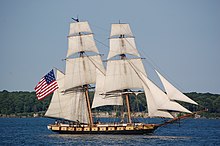
Back Brik Afrikaans بريغية Arabic Briq Azerbaijani Брыг Byelorussian Бриг (кораб) Bulgarian Bergantí Catalan Briga Czech Бриг CV Brig Welsh Brig Danish


A brig is a type of sailing vessel defined by its rig: two masts which are both square-rigged. Brigs originated in the second half of the 18th century and were a common type of smaller merchant vessel or warship from then until the latter part of the 19th century. In commercial use, they were gradually replaced by fore-and-aft rigged vessels such as schooners, as owners sought to reduce crew costs by having rigs that could be handled by fewer men. In Royal Navy use, brigs were retained for training use when the battle fleets consisted almost entirely of iron-hulled steamships.
Brigs were prominent in the coasting coal trade of British waters. 4,395 voyages to London with coal were recorded in 1795. With an average of eight or nine trips per year for one vessel, that is a fleet of over 500 colliers trading to London alone. Other ports and coastal communities were also served by colliers trading to Britain's coal ports. In the first half of the 19th century, the vast majority were rigged as brigs, and that rig was retained for longer in the northeast of England.[1]: 49

- ^ MacGregor, David R (1984). Merchant Sailing Ships 1815-1850 Supremacy of Sail. London: Conway Maritime Press. ISBN 0-85177-294-3.
© MMXXIII Rich X Search. We shall prevail. All rights reserved. Rich X Search